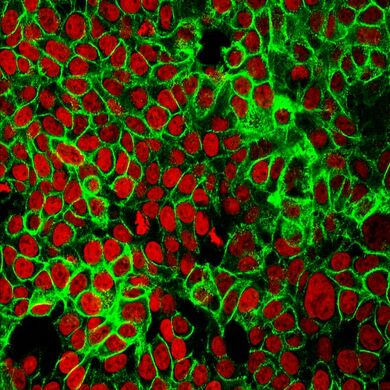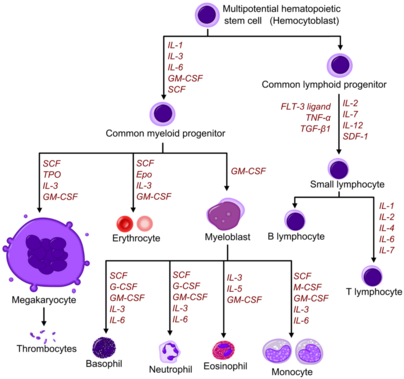Growth Factors
Original Editor - Lucinda hampton
Top Contributors - Lucinda hampton and Sehriban Ozmen
Introduction[edit | edit source]
Growth factors, now considered as a subset of cytokines, are the diffusible signaling proteins that stimulate cell growth, differentiation, survival, inflammation, and tissue repair. They can be secreted by neighbouring cells, distant tissues and glands, or cancer cells themselves. Normal cells show a requirement for several growth factors to maintain proliferation and viability. Growth advantage is often found for the cells which secrete a growth factor with the growth of each cell in the human body in diverse organs and systems being mediated by growth factors.[1]
- Growth factors are important in both normal physiological processes for example wound healing, nerve regeneration and abnormal processes for example cancer and diabetic retinopathy[2].
- The use of growth factors for therapeutic reasons is growing
Human Growth Factors VS Human Growth Hormone[edit | edit source]
Some definitions:
- A growth factor are small glycoproteins. These proteins are produced by all animal cells, whose job is to communicate with other cells (and also autoregulating the cell that produced them). Growth factors enable constant communication and feedback between nearby and distant cells, modulating cell behaviour. and maintaining the structure and function of tissues.
- Human Growth Hormones is the hormone is secreted by the pituitary gland (a small structure at the base of the brain), and helps bone, muscle and organs grow. [3]
- Growth factors with a glandular origin may be considered as hormones. Yet not all hormones are proteins and are thus not growth factors. For instance steroids are not growth factors, cholesterol make up the steroid hormones, while the amino acids make up the peptide hormones.[4]
Therapeutic Use[edit | edit source]
Several growth factors are used therapeutically. Examples include
- A swift development in the use of growth factors for accelerated healing of injury is occurring currently. Growth factors that mediate the processes needed for repair of soft tissues have been shown in animal studies to bring direct benefits in terms of accelerated healing. Platelets contain growth factors in their α-granules ( for example insulin-like growth factor-1, basic fibroblast growth factor, platelet-derived growth factor, epidermal growth factor, vascular endothelial growth factor) and these are used utilised today in techniques are known as platelet-rich plasma, autologous blood injections and autologous conditioned serum. These techniques has been studied clinically in humans on a small scale but results to date are promising for a speedier return to play following muscle and particularly tendon injury. [5]
- Erythropoietin (a growth factor), stimulates the growth of red blood cells and is used to treat anemia associated with chronic kidney failure, cancer chemotherapy, and zidovudine (AZT) therapy in AIDS patients.
- Granulocyte colony-stimulating factor and granulocyte-macrophage colony-stimulating factor are used to stimulate the production of white blood cells in patients with cancer. [6]
- Epidermal Growth Factor can be used for patients with recalcitrant skin wounds and skin aging, as it is an effective and specific mitogenic factor for the skin[7].
- Vascular endothelial growth factor is a major regulator of physiological and pathological angiogenesis. Various VEGF inhibitors have been approved by the FDA for the treatment of advanced cancer and neovascular age-related macular degeneration.[8]
- Nerve growth factor (NGF) have long been regarded as potential drugs to combat acute and chronic neurodegenerative diseases (Alzheimer’s disease; and Parkinson’s disease) and brain injuries, spinal cord injury, and also retinopathies, optic nerve degeneration, and peripheral neuropathies associated with diabetes and HIV. However to date their clinical application has been impeded by their unforeseen side effects, as well as by trouble of dosing and administration strategies.[9]
References[edit | edit source]
- ↑ Sinobiological What are growth factors Available: https://www.sinobiological.com/resource/cytokines/what-are-growth-factors (accessed 13.8.2022)
- ↑ Stone WL, Leavitt L, Varacallo M. Physiology, growth factor. Available:https://www.ncbi.nlm.nih.gov/books/NBK442024/ (accessed 13.8.2022)
- ↑ Bioserum Not all growth factors are equal Available:https://www.jbioserum.com/not-all-growth-factors-are-equal/ (accessed 13.8.2022)
- ↑ Cellsgs Growth factors, hormones, cytokines and chemokines. Available:https://www.cellgs.com/blog/growth-factors-hormones-cytokines-and-chemokines.html (accessed 13.8.2022)
- ↑ Creaney L, Hamilton B. Growth factor delivery methods in the management of sports injuries: the state of play. British journal of sports medicine. 2008 May 1;42(5):314-20. Available: https://bjsm.bmj.com/content/42/5/314.short(accessed 13.8.2022)
- ↑ Brittanica Growth Factor Available:https://www.britannica.com/science/growth-factor (accessed 13.8.2022)
- ↑ Miller-Kobisher B, Suárez-Vega DV, de Maldonado GJ. Epidermal growth factor in aesthetics and regenerative medicine: Systematic review. Journal of Cutaneous and Aesthetic Surgery. 2021 Apr;14(2):137. Available:https://pubmed.ncbi.nlm.nih.gov/34566354/ (accessed 13.8.2022)
- ↑ Ferrara N. Vascular endothelial growth factor. Arteriosclerosis, thrombosis, and vascular biology. 2009 Jun 1;29(6):789-91. Available:https://www.ahajournals.org/doi/10.1161/atvbaha.108.179663 (accessed 13.8.2022)
- ↑ Alastra G, Aloe L, Baldassarro VA, Calzà L, Cescatti M, Duskey JT, Focarete ML, Giacomini D, Giardino L, Giraldi V, Lorenzini L. Nerve growth factor biodelivery: a limiting step in moving toward extensive clinical application?. Frontiers in Neuroscience. 2021;15:879. Available:https://www.frontiersin.org/articles/10.3389/fnins.2021.695592/full (accessed 13.8.2022)









